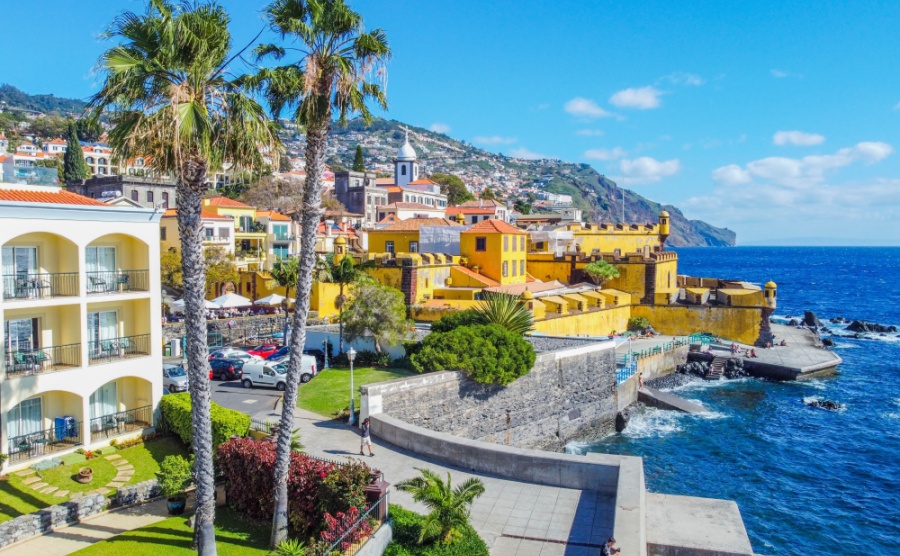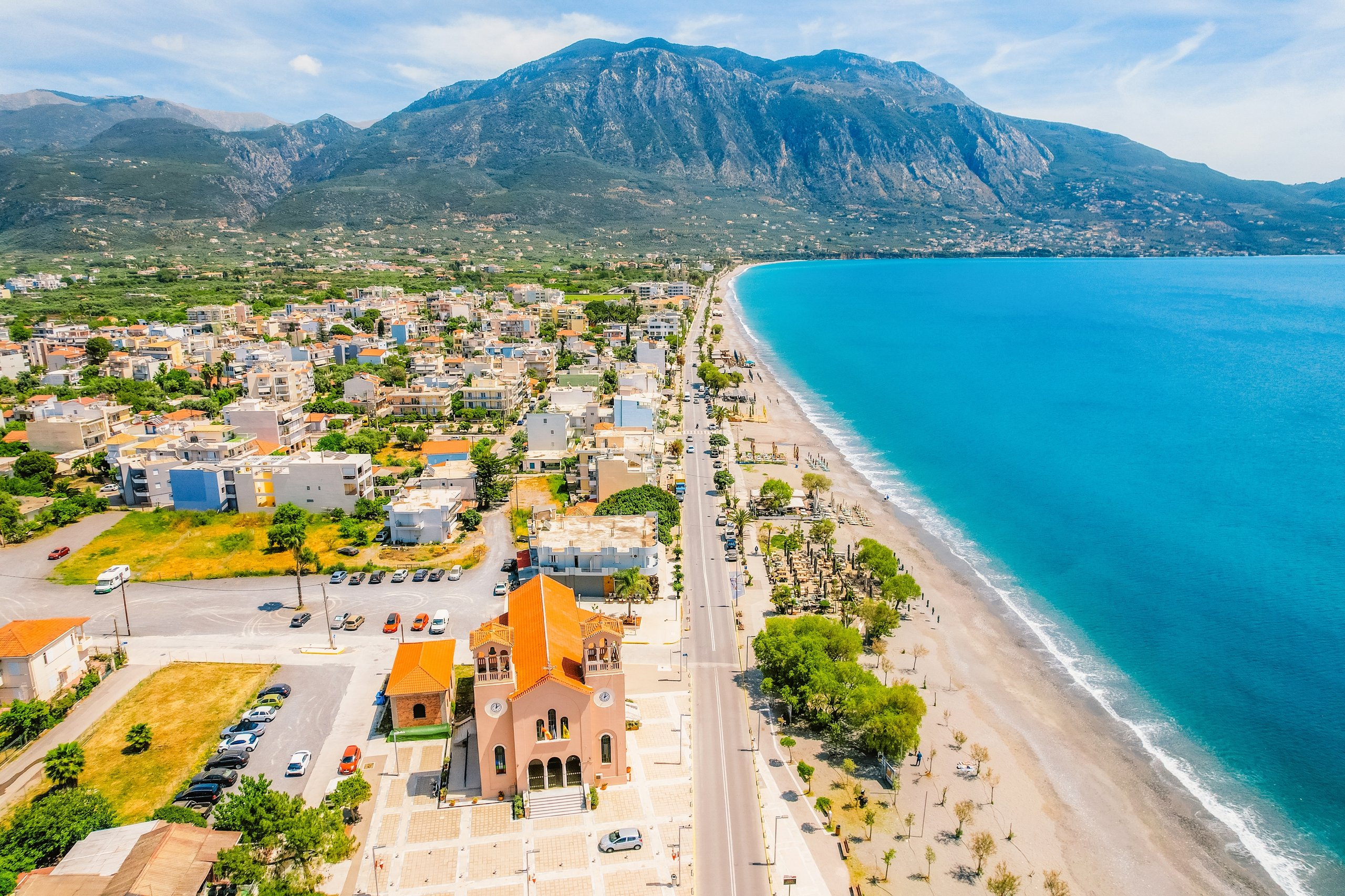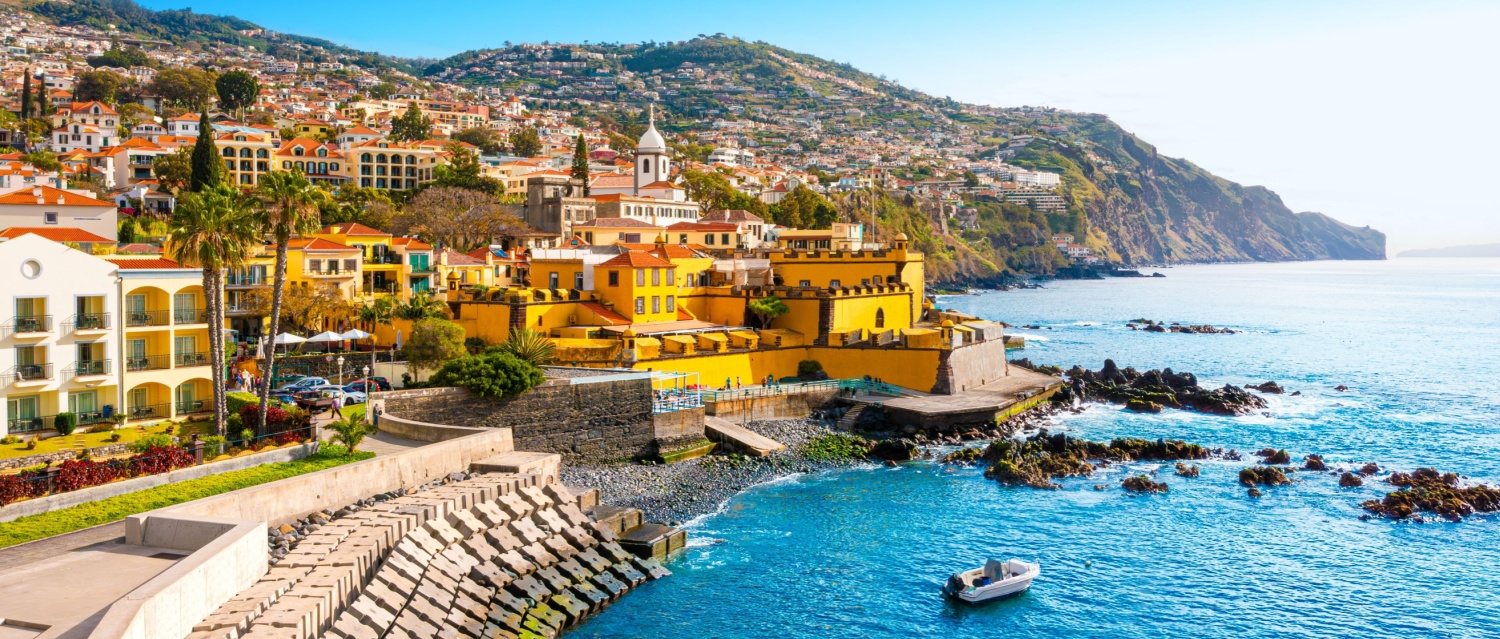Madeira, the Atlantic island known for its mild climate and dramatic landscapes, is becoming an increasingly attractive option for overseas property buyers. Often referred to as Portugal’s “island of eternal spring”, buying property in Madeira gains you a blend of culture, natural beauty and modern infrastructure that appeals to retirees, remote workers and holidaymakers alike.
Whether you’re drawn to the sunny coast or prefer a mountain hideaway, buying property in Madeira remains affordable and achievable in 2025. With straightforward legal procedures and no restrictions for foreign buyers, it’s worth exploring this verdant Portuguese territory if you’re looking for a safe and scenic property investment.
In this comprehensive breakdown, we’ll examine the benefits of buying property in Madeira, outline the process and help you decide which region suits your budget and lifestyle.
Download the Portugal Buying Guide
Contents

Why buy in Madeira?
Madeira offers a lifestyle rooted in nature, with a climate that allows residents to enjoy the outdoors year-round. The region is particularly popular with walkers, thanks to its well-preserved levada trails and mountainous terrain. Birdwatchers and nature lovers are drawn to the Laurisilva Forest, a UNESCO World Heritage Site, and divers are treated to clear waters with vibrant marine life.
However, Madeira isn’t just for adventurers. The capital, Funchal, provides the best of urban living with open-air cafés, culture and well-connected transport. Half the island’s population lives here, and the city continues to welcome more remote workers and second-home owners each year, thanks to its friendly atmosphere and excellent digital infrastructure.
You’ll find a strong sense of community in Madeira, especially in smaller towns and villages. Life moves at a relaxed pace, and despite the growth in tourism, the island has avoided overdevelopment. Combine this with Portuguese hospitality and lower living costs than mainland urban centres and it’s easy to see why so many find Madeira so appealing.
For a closer look at the purchasing process, claim your free copy of our Portugal Buying Guide:
Download the Portugal Buying Guide
Weather in Madeira
Madeira’s subtropical climate is one of its greatest assets. Temperatures vary from 18°C in January to around 26°C in summer, and while there’s more rain in the winter months, it tends to fall in brief, heavy showers. There are around 5–8 hours of sunshine per day, depending on the season.
This is one of the few European destinations where comfortable temperatures and lush greenery coexist thanks to the island’s geography – coastal areas tend to be warm and dry, while higher altitudes are cooler and misty. The sea breeze combined with mountain altitude makes life more comfortable even during warmer months.
For property buyers, this means your home will be usable throughout the year – whether you want a holiday bolthole or a base for full-time living. This consistency contributes to Madeira’s year-round tourism appeal and in turn supports rental demand.
Travelling to Madeira
Madeira is serviced by Cristiano Ronaldo International Airport, located just outside Funchal. The airport operates regular direct flights to and from major cities such as Lisbon, Porto, London, Manchester, Frankfurt and Paris. According to ANA Aeroportos data, traffic through Madeira’s airport rose by 10% in 2024.
Travel from other parts of the world typically requires a connection through a European hub like Lisbon or Madrid. During peak summer months, additional services often operate from other European cities to meet tourist demand.
For island-hopping, Madeira is linked by ferry to its smaller neighbour, Porto Santo. The journey takes around 2.5 hours and is worth doing for its long sandy beach – one of the few in the Madeira archipelago.
If frequent travel is on your mind, you’ll benefit from choosing property close to Funchal or the east coast, where airport links are strongest.
Getting around Madeira
Although Madeira is only 57km long and 22km wide, its steep terrain and winding roads can make travel challenging for those unused to mountain driving. However, road infrastructure is strong, with more than 150 tunnels and many elevated bridges that reduce travel time significantly.
Madeira’s public transport system centres on buses, with coverage strongest in and around Funchal. For more remote parts of the island, hiring a car or using local taxis is often the best option.
Cable cars provide scenic links between high and low points in areas like Monte and Funchal. For those less keen on driving, a combination of public transport and occasional car hire may be sufficient – especially if living within a walkable town or city.
When choosing where to buy, consider how confident you feel navigating narrow or steep roads. Many buyers opt for flatter areas in the south or outskirts of Funchal for ease of access.
Where to buy property in Madeira
Madeira’s property market is diverse, ranging from affordable village homes to high-end seaside villas. Statistics from Estatística da Madeira reveal that in 2023, nearly 6% of the population in the region were foreign nationals. The largest expat communities come from Venezuela, the UK and Germany.
Here are some popular locations to consider:
- Funchal: The capital offers everything from modern flats to historic townhouses. It’s ideal for digital nomads, retirees and those who want amenities close by.
- Santa Cruz: Located near the airport, this compact town has attractive beaches, cafes and a slower pace of life. It’s popular among holiday home buyers.
- Calheta: With its golden sand beach imported from Morocco, this west coast town has become a favourite for buyers seeking sea views and resort amenities.
- Santana: A rural choice for buyers who want character homes. It’s known for the traditional thatched-roof houses and tranquil countryside living.
- Câmara de Lobos: A working fishing village close to Funchal, celebrated for its heritage and colourful harbour views.
Where you buy will depend on your lifestyle preferences, budget and whether you plan to live full time or rent your home out.
Is buying property in Madeira a good investment?
Madeira welcomed over 1.5 million tourists in 2023, and the number of tourists staying is increasing in 2025. The region continues to attract visitors year-round, with British, German and mainland Portuguese tourists making up the largest share. This sustained demand fuels both property sales and rentals.
Compared to investing in Portuguese property on the mainland – and especially the Algarve – property in Madeira remains more competitively priced, offering investors better value for their money. Tight building controls and strict environmental rules limit overdevelopment, helping to protect long-term property values.
Residential space on islands is inherently limited, and Madeira is no exception. This restriction on future supply is likely to continue driving demand and supporting long-term capital appreciation.
Another key advantage is the island’s 12-month rental season. With sunny weather in winter attracting European tourists escaping the cold, holiday lets can achieve steady returns across the calendar year.
What you can buy within your budget
Madeira’s property market provides options for buyers at every level. In 2025, buyers can still find renovation properties starting around €50,000, particularly in inland villages. These may need significant upgrading but offer the chance to create a bespoke home.
For around €150,000, buyers can find character homes with modern updates or small flats in locations like Funchal or Santa Cruz. These properties can be used for full-time living, retirement or as holiday lets.
If your budget reaches €250,000 and above, you’ll have access to more spacious family houses, including sea-facing villas and newer homes with modern amenities. These are especially common in places like Calheta or Caniço, known for their expat communities and good infrastructure.
Unlike mainland Portugal, Madeira doesn’t yet have a wide choice of new-build developments, so many buyers opt for traditional homes or resale properties. That said, local builders are seeing increased demand to modernise rural properties for international buyers.
Steps to buying property in Madeira
Buying a home in Madeira involves a clear set of steps. At Your Overseas Home, we help you through each stage, from researching locations to moving into your dream property. Here’s how the process works in 2025:
- Define your budget: Decide how much you can spend, including costs like taxes, legal fees and currency transfers. Speak to Smart Currency Exchange to secure favourable exchange rates and reduce transaction risks.
- Research the market: Identify which locations and property types match your lifestyle goals. Consider factors like altitude, access and historical weather patterns.
- Secure finance (if needed): Non-resident mortgages typically require a 20–30% deposit. Get mortgage pre-approval if finance is required and speak to an English-speaking broker for help with documentation.
- Start viewing properties online: Start your search on our property portal. Work with our recommended English-speaking estate agents. Shortlist properties based on viewing videos, 3D tours and floor plans.
- Plan a viewing trip: Visit Madeira and attend scheduled viewings. Your Overseas Home can help arrange this. Engage a local, independent lawyer who speaks both Portuguese and English. For more information, download our Viewing Trip Guide.
- Make an offer: Once you’ve found the right home, submit your offer via the estate agent. When accepted, sign a reservation agreement and pay the deposit (usually 10–20%).
- Final contract and completion: The notary (notário) will verify all legal checks before you sign the final contract of sale. Completion usually occurs within 6–8 weeks. You may give your lawyer power of attorney to handle this if you’re not present.
Owning a home in Madeira is more achievable than many expect. With proper planning, expert advice and reliable local support, you can own a slice of this Atlantic paradise in a matter of months.
Need help getting started? Book a consultation with our property experts today.
Still exploring where to buy property in Portugal? Madeira offers a unique island lifestyle, but it’s worth comparing it with mainland destinations. Read our full guide to where to buy property in Portugal to see what other regions have to offer. If you’re ready to begin your journey, don’t miss our expert guide on how to buy property in Portugal, covering everything from legal steps to financial planning.
Frequently asked questions
Yes, Madeira offers year-round appeal, a safe environment and excellent infrastructure. Its mild climate, relaxed lifestyle and competitive prices make it an increasingly popular choice among retirees, second-home buyers and investors.
Yes, there are no restrictions on foreign buyers purchasing property in Madeira. The buying process is open and transparent, with straightforward legal steps and support from English-speaking professionals.
Prices start from around €50,000 for renovation projects inland. Flats in towns like Funchal or Santa Cruz can be found from €150,000, while sea-view villas and modern homes typically begin at €250,000.









